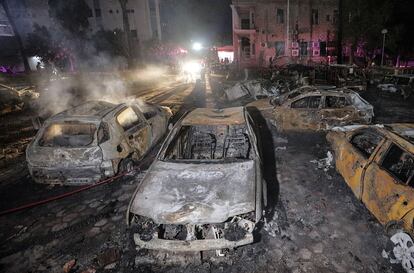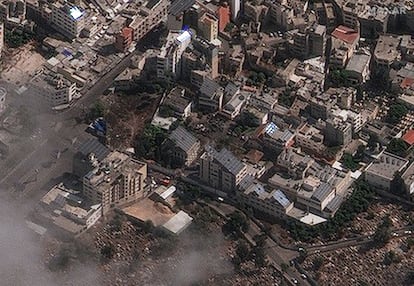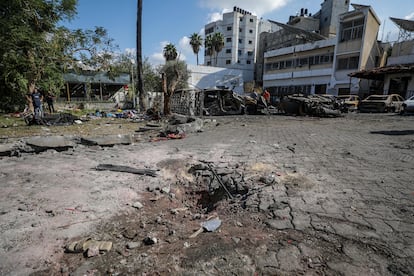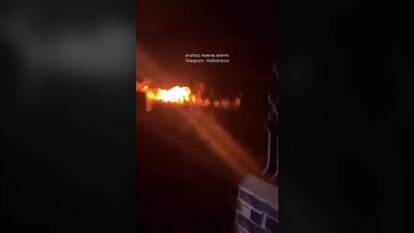A reconstruction of the Al Ahli hospital massacre in Gaza that set the Islamic world on fire
Most investigations concur: the projectile that hit the health center was launched from within the Strip

On October 17th, a powerful explosion hit a civilian area of the old city of Gaza, between the neighborhoods of Shejaiya and Zeitun, in the northern part of the Strip. The first news appeared a few minutes later, as well as the first videos, both through social media and news services. One of them, taken from a house near the place, which was geolocated and verified, reproduces the moment in which a descending whoosh precedes the explosion; then a strong, high flare, and columns of smoke.
The first messages reported that the Al Ahli Arab hospital had been hit by an Israeli attack. Almost immediately, Hamas accused Israel of bombing the healthcare facility, where, according to the first communication from the Palestinian militia, between 200 and 300 people had died, while hundreds of wounded remained “in the rubble” (the Gazan health ministry later raised the number of fatalities to 471). After just over three hours, the Israeli army stated that Islamic Jihad, the second-strongest armed group in Gaza, had been responsible for what happened.
A week later, without an independent investigation or foreign press on the ground due to the Israeli blockade of the Strip, it is still not possible to know with certainty what hit the Al Ahli hospital and where it came from. However, the analysis and verification of the recordings and photographs spread during those hours through social networks and the media, as well as the inspection of ground zero of the tragedy that was carried out on the morning of the 18th, offer an approximation to what happened: most of the journalistic and government investigations indicate that the projectile that caused the death of dozens of civilians in Al Ahli on the afternoon of October 17th was launched from inside Gaza.

First of all, it is necessary to define what happened at the hospital. According to the Geneva Convention, an “attack” is an act of violence against an adversary. Thus, we would need to know the reasons behind the explosion, in the event that it was caused by some type of projectile; whether Israel deliberately bombed the center, to which it had sent three “evacuation notices” on the 14th, 15th and 16th, according to information from the Episcopal Diocese of Jerusalem, to which the hospital is linked, or whether the impact was the result of an error in one of the rockets launched that afternoon by the Palestinian militias in the Strip and, therefore, an accident.
One of the keys to getting closer to what could have caused the explosion and the death of dozens of people is a live broadcast done by the Qatari network Al Jazeera from inside the Strip. The channel analyzed images recorded after 6:45 p.m., local time, in which it identifies four Israeli bombings. They take place between 6:54 p.m. and 6:58 p.m. A minute later, a camera that is being used to do a live broadcast with an Al Jazeera reporter turns and captures a light, similar to that left by the rockets of the Palestinian militias, that rises at a decreasing speed until it disappears after a burst of light. It is 6:59 p.m. The Qatari channel’s investigation team reported that the projectile was intercepted by the Israeli Iron Dome air defense system.
This version has been refuted by some analysts consulted this week by Western media: the Iron Dome is a system that acts when the rockets fired from Gaza are on a downward trajectory and approach an Israeli position, just like other anti-aircraft defense systems do. Shortly before the Al Jazeera camera saw the rocket ascending alone, at least two fixed cameras located in Israeli territory north of the Strip and pointed in the direction of Gaza (one in Tel Aviv and another south of Ashkelon, in Netiv Haasara), as verified by Associated Press and The Wall Street Journal, recorded the launch of a long series of projectiles.
An Israeli statement issued on the 18th put the number of rockets launched in that series at around ten. However, the images recorded from Israeli territory suggest that this number would actually be closer to twenty. The army blamed this — in line with the Israeli version of what happened so far — on Islamic Jihad. Both this group and the armed wing of Hamas, the Izz ad-Din al-Qassam Brigades, reported attacks against Israeli territory through their social media accounts during the afternoon of the 17th.
The camera in Tel Aviv captures the same lone rocket which, after the launch of multiple projectiles, overflies erratically. Just a few seconds after it explodes in the sky, following the Al Jazeera footage, a first explosion takes place in the background, in an apparently sparsely populated area, followed by a second, which is the one that impacts the Al Ahli hospital. Although the timestamp of the videos that captured the missile launch coincide, in a sequence that leads to the two explosions on the ground, there is no visual evidence that connects the explosion of the projectile in the sky with the massacre; no projectile or fraction of a rocket can be identified at that time of night in the different recordings.
Although the first reports indicated that the alleged attack had hit the hospital, photographs and videos taken in daylight — including those captured by Palestinian photojournalist Mohamed al Masri — showed that ground zero of the massacre was actually located in the parking lot of the healthcare center, under the open sky. In those first images from the morning of the 18th, a dozen cars appear completely burned or badly damaged. Approximately 50 feet away, other vehicles had suffered much lighter damage.

Through these images of the area, taken in broad daylight, and based on the size of the parking lot and the green areas next to the impact zone — where dozens of people, fleeing the Israeli bombings, had been taking refuge for days — experts in geolocation and verification, like Nathan Ruser, analyst from the Australian Strategic Policy Institute, have questioned whether the number of fatalities really amounted to almost 500. The U.S. intelligence service has estimated, according to a document obtained by Agence France-Presse, that the death toll could range between 100 and 300.
One of the photographers on the ground is Mohamed Saber, who distributed through the EFE agency one of the first images of the crater caused by the projectile that hit the Al Ahli parking lot. The hole, shallow and approximately three feet in diameter, forms an impact cone that goes from northeast to southwest. According to several experts, including U.S. military advisor Marc Garlasco, an expert in the investigation of war crimes, what hit the floor of the parking lot did not come from an airstrike. “Even the smallest JDAM [guided missile] causes a 3m [10-foot] crater,” Garlasco tweeted.

The videos that were taken from inside the Al Ahli facilities also reveal damage to the facades of some of the center’s lower buildings, including a Baptist church, remains of the explosion and the effect of the impact of parts of the projectile after hitting the ground. So far, no photograph or video has shown any remains of what caused the massacre inside the hospital.
One day after the massacre, on an official trip to Israel, U.S. President Joe Biden stated that, according to the information in his possession, the massacre had been caused by the failure of a rocket fired from Palestinian territory. The United Kingdom echoes this conclusion, reports Rafa de Miguel: “On the basis of the deep knowledge and analysis of our intelligence and our weapons experts,” British Prime Minister Rishi Sunak told the House of Commons on Monday, “the British government judges that the explosion was likely caused by a missile, or part of one, that was launched from within Gaza towards Israel.”
The French investigations coincide with London and Washington. As reported by Agence France-Presse, the analysis carried out in Paris was even able to quantify the explosive charge that impacted the hospital at around five kilograms.
The level of destruction at the Al Ahli facilities is much lower than what a guided missile can cause, and it is closer to what a rocket or an artillery piece would do. The force of a projectile from an Israeli attack, as the army itself has disseminated recently through graphic evidence — and as images from Ukrainian civilian areas hit by Russia attest every day — would destroy not only the objective, but also the surrounding buildings through the shock wave. In the aforementioned video that shows the explosion from a closer viewpoint, taken from a home, the enormous flare that follows the roar stands out; this could be due to the incendiary effect of the projectile’s fuel.
Finally, the forensic analysis of the crater through graphic material has allowed one of the best projects of verification through open sources, the London-based Forensic Architecture — which has done brilliant work in the region, such as the reconstruction of the death of journalist Shireen Abu Akleh in Jenin by Israeli fire — to trace the possible direction from which the projectile arrived at the parking lot of the Gaza hospital. According to its analysis and three-dimensional projection, what hit the Al Ahli center came from the northeastern area, not from the southwest, as the Israeli army explained through its statements in the first hours after the massacre.
3D analysis shows patterns of radial fragmentation on the southwest side of the impact crater, as well as a shallow channel leading into the crater from the northeast. Such patterns indicate a likely projectile trajectory with northeast origins. pic.twitter.com/v6g6jRiXps
— Forensic Architecture (@ForensicArchi) October 20, 2023
Brenda Valverde Rubio contributed to verifying the images for this article.
Sign up for our weekly newsletter to get more English-language news coverage from EL PAÍS USA Edition
Tu suscripción se está usando en otro dispositivo
¿Quieres añadir otro usuario a tu suscripción?
Si continúas leyendo en este dispositivo, no se podrá leer en el otro.
FlechaTu suscripción se está usando en otro dispositivo y solo puedes acceder a EL PAÍS desde un dispositivo a la vez.
Si quieres compartir tu cuenta, cambia tu suscripción a la modalidad Premium, así podrás añadir otro usuario. Cada uno accederá con su propia cuenta de email, lo que os permitirá personalizar vuestra experiencia en EL PAÍS.
¿Tienes una suscripción de empresa? Accede aquí para contratar más cuentas.
En el caso de no saber quién está usando tu cuenta, te recomendamos cambiar tu contraseña aquí.
Si decides continuar compartiendo tu cuenta, este mensaje se mostrará en tu dispositivo y en el de la otra persona que está usando tu cuenta de forma indefinida, afectando a tu experiencia de lectura. Puedes consultar aquí los términos y condiciones de la suscripción digital.
More information
Archived In
Últimas noticias
Alain Aspect, Nobel laureate in physics: ‘Einstein was so smart that he would have had to recognize quantum entanglement’
Imelda Castro, the woman who wants to rule the cartel battleground of Sinaloa
The new victims of the Republican war on Obamacare: Millions hit by soaring health insurance premiums
A country divided on migrant rights: Some US states expand protections while others restrict them
Most viewed
- David King, chemist: ‘There are scientists studying how to cool the planet; nobody should stop these experiments from happening’
- Reinhard Genzel, Nobel laureate in physics: ‘One-minute videos will never give you the truth’
- Oona Chaplin: ‘I told James Cameron that I was living in a treehouse and starting a permaculture project with a friend’
- Sinaloa Cartel war is taking its toll on Los Chapitos
- Mexico completes its trade shift with the entry into force of tariffs on China and countries without trade agreements












































